Contents
Probably, even not very experienced cow owners understand that it is difficult to expect high milk productivity from first-calf heifers. Nevertheless, it depends on how correctly the first-calf heifer is milked, how much milk she will give in the future. It is important at this stage to build normal relationships with the future breadwinner of the family and understand how suitable she is for this role.
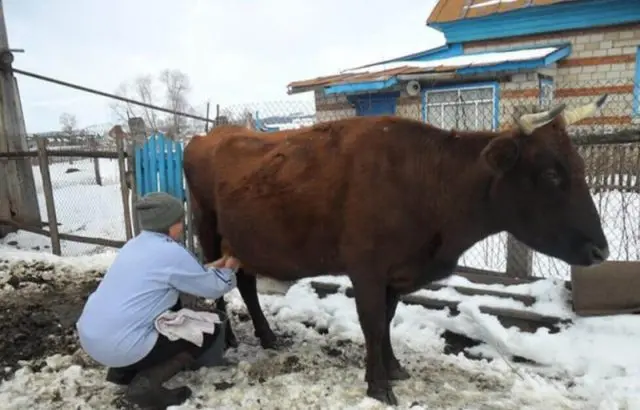
Features of milking a heifer
A cow is not able to give milk at all 365 days a year, as some people who are far from animal husbandry think. The lactation period begins from the moment of calving and lasts an average of about 300 days. Moreover, for the first 7-10 days, the cow has colostrum and the so-called transitional milk, which is absolutely necessary for the full feeding of the calf, but is not suitable for human consumption because of its too high fat content. Then the so-called milking period lasts for about 90 days, during which the maximum amount of annual milk yield is formed – up to 45%. In the next 100 days, the cow during milking gives about 30-35% of milk, but the fat content and protein content increase in it. And in the remaining 100 days, only 25% of milk can be obtained from a cow, but it is characterized by a maximum content of proteins and fats. This is followed by the so-called dry period (60-65 days), during which the cow rests and recuperates for the next lactation period.
Approximately 2,5-3 months after calving, a cow usually happens with a bull, so that the next year the cycle repeats again.
Thus, the most important period, which determines both the annual milk yield and the further milk development of the cow, is the time period within 3 months after calving. For a first-calf heifer, it is especially important, since it is necessary at the same time:
- milk her after calving;
- determine the optimal composition of the forage base;
- set the appropriate mode of care.
Actually the correct distribution during this period includes:
- massage;
- milking;
- advance feeding;
- adherence to a clear daily routine and basic rules of content.
How many times to milk a heifer after calving
Immediately after calving, a large amount of colostrum can accumulate in the udder. In addition, during the first 7-8 days, udder edema is often observed in first-calf heifers, which usually subsides safely on its own by 8-10 days. Therefore, in order to milk a cow after the first calving, it is recommended to carry out this procedure as often as possible – 5-6 times a day.
If machine milking is used, then it is possible to stop at three times milking, but in this case, 1-2 hours after each milking, the first heifer must be milked again with the help of machinery.
Gradually, after the udder edema subsides, the number of procedures associated with milking can be reduced. And go first to a 4-time, and then to a 3-time milking. But if you deal with high-yielding dairy animals, then milking less than 3 times a day can adversely affect the overall milk production. Therefore, it is better to stop at milking 3 times a day with equal intervals of about 8 hours.
How to milk a cow
Proper feeding is one of the main components of the milking of the first heifer, both at home and in industrial conditions. In this case, the so-called advance feeding is used. Its essence lies in the fact that, in addition to the usual norm, the feed is regularly supplemented with several components that can increase the milk productivity of the first-calf heifer. Most often, concentrated feed and beets are used for this purpose.
In this case, the total amount of additives for the period of distribution of first-calf heifers can reach:
- for high-yielding cows (productivity from 25 liters per day) – more than 50%;
- for all others – at least 40%.
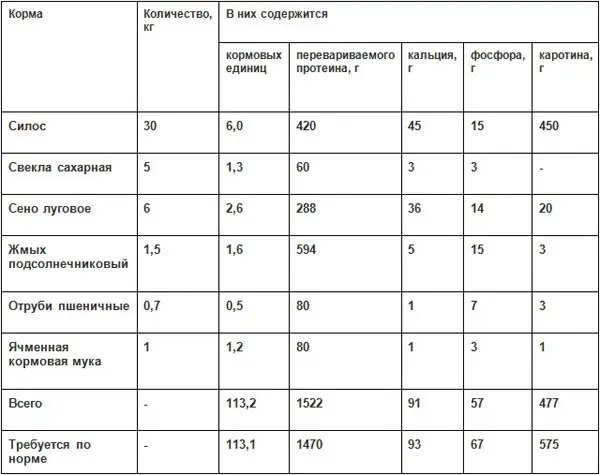
It makes sense to switch to a new type of feeding no earlier than 10 days after the birth of the calf. Indeed, immediately after calving, the entire body of the first-calf heifer as a whole is slightly weakened, as well as the work of the gastrointestinal tract. It is impossible to immediately pile on such a load, and the mammary glands must normalize their work, otherwise there is a risk of developing mastitis.
From about day 10, you can start introducing a new feeding system, adding 1,5-2 additional feed units to the standard diet every week.
But the essence of the advance feeding system is that supplements should always be fed a little more.
For example, if a heifer gives daily 20 liters of milk, then you should add as much concentrated feed to her as if she were already giving 25 liters. After 4-7 days of such feeding, the milk productivity of the first-calf heifer really goes up and reaches the calculated norm. In this case, it is necessary to increase the amount of added concentrates again. So they continue to act until the milk productivity of the first-calf heifer stops growing. After that, the feed level is maintained at the same level for another 10 days, and then they gradually begin to reduce it to the standard one.
As a result of the operation of this feeding system, it is possible to increase the initial milk yield of the first-calf heifer by 28-30%.
It is equally important to adhere to a certain regimen in the care of the first-calf heifer. First-calf heifers need to be given food at strictly defined intervals. Also, milking should take place strictly by the hour. The body of cows quickly gets used to a certain schedule and begins to produce the maximum amount of milk by the hours when milking occurs. It is very important to give heifers an unlimited amount of water, changing it to fresh water at least 3 times a day.
During the warm season, it is equally important to send cows to pasture daily. Since walking in the fresh air also contributes to the maximum return of milk.
How to properly milk a heifer
The milking itself and the accompanying massage are the most important elements in the milking of the first-calf heifer.
For most animals, it is very important to accustom them to this procedure from an early age. Already from the age of several months, it is advisable to regularly feel and do a light massage of the udder, at the same time washing it from possible contamination. If the heifer has not been on the farm since birth, then you should start accustoming her to the milking procedure immediately after meeting her. This will allow you to establish closer contact with the animal and gain his trust even before the first calving. Although rare, there are individual individuals that have an overly violent and excitable character and do not let them near their udder until calving. The following will describe several ways to deal with this situation.
Milking a heifer at home is not always easy, and in this case it is difficult to overestimate the importance of udder massage. Massage is able to stimulate blood circulation in the mammary glands and increase milk flow, due to the work of special hormones. It can also improve the quality and fat content of milk. Massage before and after milking is especially useful and necessary for first-calf heifers, as they are often characterized by tightness.
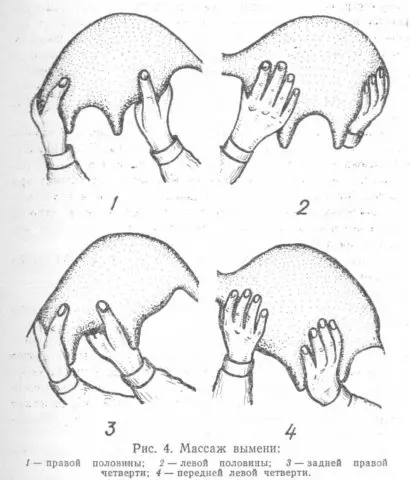
Before milking, a preliminary massage is carried out, clasping each of the 4 lobes with both hands. Then:
- stroke and massage the tissues of the udder from top to bottom and in the opposite direction;
- slightly lift it on the palms, imitating the movements of a calf, and shake it slightly;
- they massage the nipples of the first-calf heifers themselves, but without decanting anything.
After the main part of the milking has been carried out, the final massage is carried out, which consists of almost the same movements. But in addition, the udder of the first-calf heifer is still kneaded entirely in the direction from the sides to the center and from top to bottom, feeling and removing all possible seals. After that, you can carry out more milking and collect some additional milk.
Finally, the udder of the heifer is wiped with a damp cloth, then dried with a towel and the nipples are smeared with petroleum jelly or a special cream after milking.
Milking can be done in two ways:
- manual;
- using a milking machine.
Before milking itself, the udder must be wiped or even washed with warm water and a cloth napkin if there is dirt. Then massage is carried out and only after it they start milking.
Manual milking of heifers must be carried out with the so-called fist. That is, the nipple is taken completely into the hand, the thumb and forefinger pinch its base, and then, by squeezing all the other fingers, a trickle of milk is squeezed out of the nipple. At first, the movements must be careful and smooth, then the milking speed must be increased so that the return of milk also increases.
First, two shares are handed over, then the next two, or alternating them. Milk should be fully milked, it is very important to do this especially for the first heifer. Since it is complete milking that stimulates the process of milk formation and prevents many diseases of the udder.
The milking machine is usually used on farms where it is difficult to milk a large number of cows by hand. But first-calf heifers are recommended to be milked manually in the first weeks after the birth of calves and only gradually accustomed to milking by the machine.
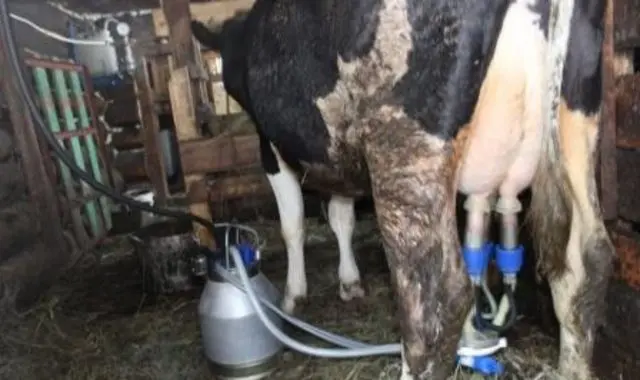
In any case, massage procedures before and after milking remain mandatory for heifers, even if automated milking is used.
How to milk a heifer if she is beating
Many first-calf heifers are very afraid and do not approve of the milking procedure itself from the first time. The most impulsive of them may begin to beat with their legs or tail.
Of course, it is not so easy to properly milk a rabid heifer even for an experienced owner or housewife. But a combination of gentle handling with some special techniques will help overcome this problem.
One technique that often helps to subdue a recalcitrant animal is to lift one front leg and tie it to a post. Standing only on three limbs, the first heifer will not be able to kick and will gradually get used to his new role.
Another technique is that before milking the heifer, a piece of heavy cloth soaked in warm water is placed on the back or withers. This helps the animal to relax, and it will be easier to relate to the milking procedure.
How to accustom a heifer to milking by folk methods
Since ancient times, people have also developed many ways to deal with a harmful first-calf heifer if she does not want to put up with the milking procedure and stand calmly.
Those who want to cope with the help of love, affection and good attitude can try to start by tying the heifer by the horns in the stall. But not very short, but so that she simply could not leave the stall. Then they put a container with delicious food in front of her, and gradually begin to milk one nipple into a mug. After filling, the contents of the mug are immediately poured into a nearby bucket. After a couple of times of such milking, you can try to milk for two nipples. Soon the first heifer will get used to it and there will be no more problems with it.
There is another effective way – to collect the folds of the skin on the back and keep them in this form during milking.
Finally, an interesting way to deal with a heifer during milking without violence is to comb it with another human assistant during the entire milking procedure. After a week, the cow gets used to it and stands without any problems.
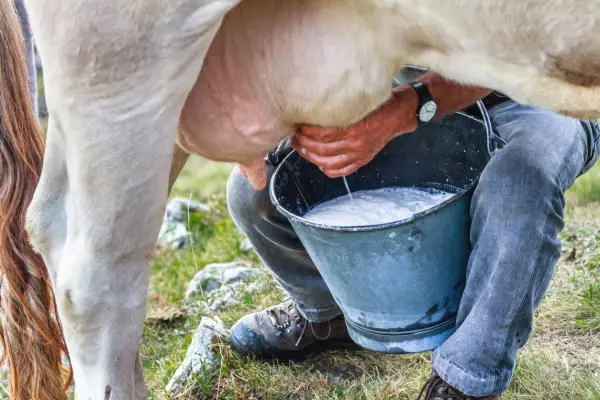
What affects the milk production of a cow
A cow’s milk production can be influenced by many factors:
- Breed and heredity. The most dairy are Ayrshire, Holstein.
- Age. The milk yield of a cow increases by 5-7 calving, and then gradually decreases.
- Health status.
- The quality and quantity of food.
- The length of the dry period.
- Timely, not late and not early heifer coverage.
- The shape of the udder. The most productive cows are considered to be with cupped and tub-shaped udders.
- duration of the lactation period. Its increase leads rather to a decrease in total milk yield in the next season.
- Live weight of cows.
- calving season. In winter, milk productivity increases by 10%.
- Udder massage and proper milking.
Conclusion
It is not always easy to milk a first-calf heifer correctly, but with a strong desire, this problem can be dealt with. The main thing is to truly love your animals and spare no time and effort to care for them.









